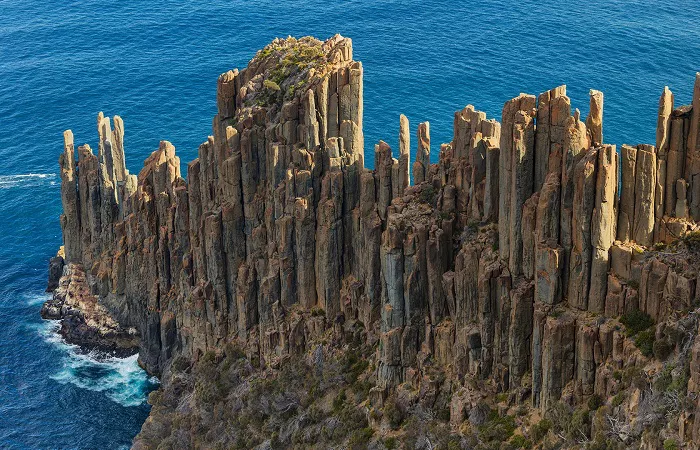TASMANIA — Australia’s island state may be small in size, but it boasts a spectacular natural offering that rivals any corner of the continent. With 19 national parks covering over 40% of the island, Tasmania is a haven for lovers of rugged wilderness, ancient forests, coastal drama and alpine tranquility.
From the towering sea cliffs of the Tasman Peninsula to the pristine bays of the east coast and the snow-capped peaks of alpine interiors, Tasmania’s national parks present an unrivalled blend of scenic diversity and ecological richness. As 2025 approaches, these are the parks set to captivate nature lovers, hikers and adventure seekers alike.
Tasman National Park: Coastal Drama and Towering Cliffs
Located on the rugged Tasman Peninsula, Tasman National Park features Australia’s highest sea cliffs, rising in dolerite spires above the wild Tasman Sea. These towering formations, interspersed with dense coastal forests, provide a dramatic backdrop for one of the state’s most celebrated walks—the 46-kilometre Three Capes Track. The multi-day hike offers breathtaking views and diverse terrain, making it a must for outdoor enthusiasts.
Rocky Cape National Park: Small in Size, Rich in Heritage
Despite its modest scale, Rocky Cape National Park in Tasmania’s northwest delivers a powerful mix of geological wonder and cultural significance. Twisted rock formations, tidal pools and ancient Aboriginal rock shelters define the landscape. Scenic walking trails like the Banksia Grove and Caves Circuit guide visitors through diverse terrain and offer insight into thousands of years of Indigenous heritage.
Mount Field National Park: A Park for All Seasons
As Tasmania’s oldest national park, Mount Field is a destination for every season. Autumn brings brilliant foliage, while winter transforms the park into a snowy playground. The park’s crown jewel is Russell Falls—a three-tiered waterfall so iconic it once featured on an Australian postage stamp. Whether exploring mossy rainforests or alpine terrain, visitors are rewarded with ever-changing beauty.
Cradle Mountain–Lake St Clair National Park: Iconic Wilderness and Legendary Trails
Renowned for the Overland Track, a 65-kilometre alpine trek through varied wilderness, Cradle Mountain–Lake St Clair National Park is a showcase of Tasmania’s highland majesty. Cradle Mountain itself towers above the reflective Dove Lake, providing one of the island’s most iconic vistas. At its southern end lies Lake St Clair, Australia’s deepest freshwater lake, enveloped in a serenity that belies its ancient glacial origins.
Freycinet National Park: Pink Peaks and Pristine Bays
Freycinet National Park, on Tasmania’s east coast, is famed for its pink granite peaks, white sand beaches and the azure waters of Wineglass Bay—one of the state’s most photographed locations. Adventurous visitors can embark on a guided trek of the Freycinet Peninsula, combining natural beauty with local insight, refreshments and panoramic views.
Walls of Jerusalem National Park: Remote Beauty for the Committed Explorer
Accessible only on foot and requiring a three-hour hike just to reach its boundary, the Walls of Jerusalem National Park rewards determined visitors with dramatic alpine landscapes. Pencil pine forests, glacial lakes and craggy peaks create a secluded haven for experienced hikers seeking solitude and raw beauty in Tasmania’s central wilderness.
Strzelecki National Park: Wildlife and Wilderness on Flinders Island
Strzelecki National Park, situated on Flinders Island, is a wildlife haven teeming with wombats, wallabies, potoroos and over 100 bird species. Its coastal scenery and the granite Strzelecki Peaks offer striking vistas and rewarding hikes through diverse terrain, making it a dream for nature photographers and animal lovers alike.
Maria Island National Park: Where History Meets the Natural World
Just off Tasmania’s east coast, Maria Island is only accessible by ferry and is home to one of Australia’s best-preserved convict sites. The island also features unique geological formations like the Painted Cliffs, and abundant wildlife. Maria Island National Park is a rare convergence of cultural heritage and natural wonder.
Ben Lomond National Park: Alpine Majesty Above the Clouds
Ben Lomond National Park is a high-altitude wilderness where alpine plateaus and dolerite peaks dominate the landscape. The ascent via Jacob’s Ladder, a winding mountain road, delivers both thrill and reward. At 1,500 metres, the summit offers panoramic views and transforms into a winter sports haven when the snow arrives.
Bay of Fires Conservation Reserve: Pristine Beauty on Tasmania’s Northeast Coast
Named one of the world’s most beautiful beaches by Lonely Planet, the Bay of Fires features vibrant orange lichen-covered boulders, white sands and turquoise seas. Spanning a stretch of the northeast coast, the reserve includes hidden coves and peaceful beaches, making it a picture-perfect escape for coastal exploration.
Southwest National Park: The Wild Heart of Tasmania
As the largest national park in Tasmania, covering more than 600,000 hectares, Southwest National Park represents the untamed soul of the island. Accessible only to the most adventurous, the park features dense forests, dramatic ranges and the challenging South Coast Track—a multi-day hike culminating at the southernmost point of Australia.
Mount William National Park: Remote Beaches and Wildflower Beauty
Located in Tasmania’s far northeast, Mount William National Park offers tranquility and untouched beauty. Famous for its powdery white beaches and colourful wildflower displays, the park also invites underwater exploration of vibrant marine habitats. Its remote charm makes it ideal for a peaceful and immersive nature retreat.
Tasmania’s national parks are more than protected landscapes—they are gateways into a world where time slows, nature reigns and every trail leads to a new discovery. In 2025, these parks will continue to affirm the Apple Isle’s place as one of the most spectacular natural destinations in the world


